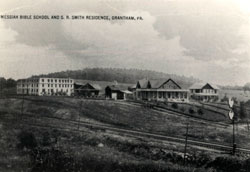Born in 1853 on a farm in what is now Hershey, Pennsylvania, Samuel Rogers Smith was a naturally soft-spoken but determined man.
As a youngster, he excelled in the classroom, passing his teacher’s examination at the early age of 15, therefore allowing him to instruct a class of his own. Because many of the students were older than Smith, he struggled to control and discipline them.
This experience, however, was an opportunity that paved the way toward a future of founding a tiny Bible and missionary training school. That school would soon become a thriving college with a rich history.
To gain more knowledge and credibility, Smith attended Eastman National Business College in Poughkeepsie, New York.
Although he was already well-versed in the business world and had from a young age been advising professionals, he was insistent on pursuing a degree. He stood out as a distinguished student, acquiring notable skills as a mathematician and businessman. He even took over his professors’ classes when they were unable to get the point across to their students.
Smith was also an active member of the school’s debate team. The team specialized in disputing the “Christianity versus atheism” argument. Once an adamant nonbeliever, Smith served his team well in arguing against fundamental Christian beliefs.
Smith graduated at the top of his class and went on to attend Columbia College. There, he received a master’s degree.
In 1874, he married Elizabeth Light. In courting her, he kept his atheist views to himself until a certain occurrence dramatically changed his beliefs.
While walking in a field one day, Smith stumbled upon a perfect four-leaf clover. After finding such perfection, he had an epiphany, announcing, “There must be a God!” His faith sky-rocketed and Smith fully devoted himself to the Lord. He became an active and committed member of the Brethren in Christ Church, where he rose in the hierarchy to become General Conference secretary.
In 1879, he entered the milling industry with his brother-in-law John Light. Due to economic hardships, the business failed soon thereafter. This flop did not fare well for the Smith family. Family accounts describe a time when their children became so hungry that they took their old clothes and sold them for money to buy a loaf of bread.
Fortunately, Smith was finally able to find work in the drug sales industry. To supplement his earnings, his wife Elizabeth began cooking noodles to sell to their neighbors. The noodles became a hit and eventually the family’s main source of income.
As the father of 10 children, money was not his only concern. Smith decided he wanted his children to have an education centered in the values of the Brethren in Christ tradition. Because no such school existed, Smith concocted the idea of starting one with the backing of the Church. Although his proposal met heavy opposition, the plan was eventually approved, and Smith became the founding president of Messiah Bible School and Missionary Training Home in 1909.
Smith founded this school on the principle that all Christians were to be admitted regardless of their race, sex, or creed.
To house the students, Smith donated his home in Harrisburg: Messiah’s original site. There, the first 12 students took their classes tuition-free. Students who chose to live “on campus” paid only $3.25 per week.
Located in the city, Smith and his colleagues wanted to ensure that the students steered clear of worldly influences. Many restrictions were placed on their activities. Teachers even limited their exercise to a small area surrounding the school so that they would avoid trouble.
The school’s primary focus was preparing youngsters for lives of Christian service. School days were often characterized by taking Bible classes, sharing testimonies, singing hymns together, and attending revival services. The school did, however, offer a high school curriculum in addition to its Christian instruction.
By 1911, the Harrisburg location became overcrowded. Smith decided to move the campus to Grantham, where city life could be evaded and agricultural training would be more practical.
Again, President Smith donated his land, nearly five acres, as the new home of the college.
Old Main was then constructed and housed the chapel, library, dining hall, kitchen, 35 dorm rooms, and 7 classrooms.

S. R. Smith's Grantham home and Old Main |
To entertain themselves in Grantham, students often took advantage of the train’s convenient location and rode into Harrisburg to attend concerts and lectures. Students also enjoyed swimming, ice skating, and boating in the Yellow Breeches.
As enrollment increased throughout its early years, the institution was slowly becoming a success story.
Just seven years after Messiah's inception, Smith unexpectedly died.
What was happening in the world during S.R. Smith's presidency?
- Titanic’s construction had just began.
- Arizona and New Mexico were named the newest states in the U.S. in 1912.
- Cracker Jacks became a popular fad.
- Woodrow Wilson was elected president in 1912.
- The sinking of the Titanic in April 1912 resulted in a loss of more than 1,500 lives.
- The first long distance telephone call was made.
|









